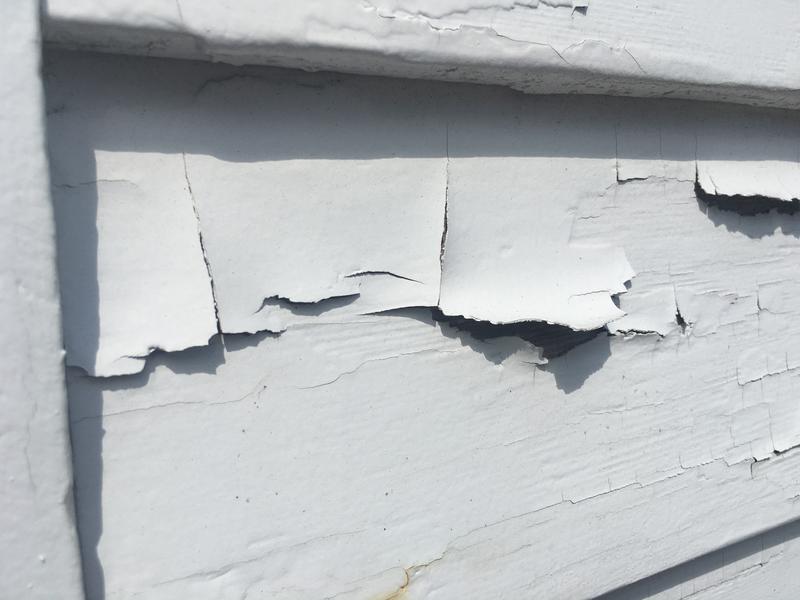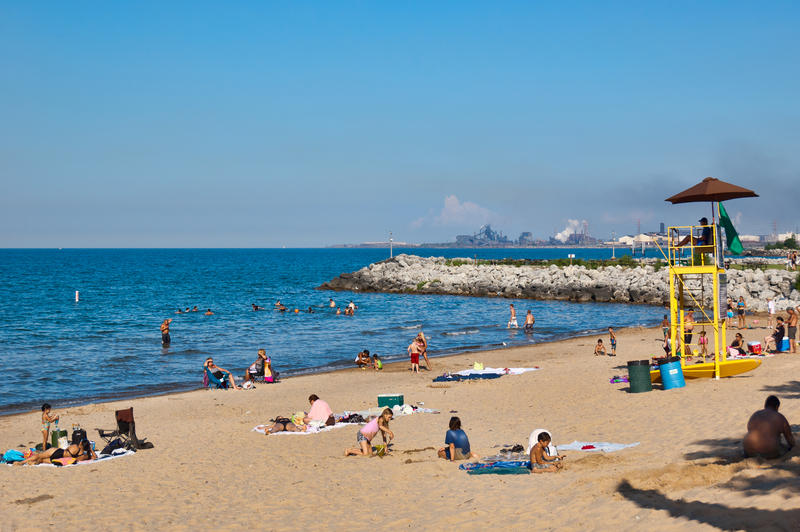
Lead paint peeling off the side of a home. (Mike Mozart/Flickr)
Is my drinking water safe? How can I find out what polluted sites are in my neighborhood? Several of our audience members wanted to know the answer to these questions and more.
We compiled a list of resources so you can find out more about pollution in your home and in your community.
What industrial companies are putting out pollution in my area?
The Environmental Protection Agency has something called the Toxics Release Inventory — which tracks how much pollution (aka “releases”) industrial facilities are putting into the air, water, land, or shipping off to another site. Indiana is one of the highest ranking states for toxic releases.
To find industrial companies near you, scroll down to the bottom of this link and type in your address.
There is a lot of jargon here, so we’d recommend looking at these tabs on the left sidebar: Under the “Facilities Summary” tab you can find a map of where those industrial companies are, scroll down to see a bar graph showing how pollution from those facilities has gone up or down over time, or look at the “top five establishments” to see which of those companies puts out the most pollution.
Under the “Releases” tab, you can see what chemicals are being put into the air, land, and water. Go to the “Potential Health Effects” tab to find out more about what health impacts you could see from being exposed to those chemicals. You can also see if any of these companies has had pollution violations through the “Compliance and Enforcement” tab.
It may not be easy to figure out what a single violation was, however. So you might want to contact the people who put together the EPA’s online enforcement and compliance database if you have questions.
What are some polluted properties in my neighborhood?
Many of these abandoned sites have left over pollution from when the property was used for something else — like a factory, a gas station, or dry cleaner. They fall into two categories — brownfields and Superfunds.
According to the EPA, a Superfund has enough contamination that it poses a risk to human health and/or the environment. A brownfield has less contamination and poses less of a risk, but brownfields often have to be cleaned up in order for new development to move in — which can stifle economic growth.
You can check out Indiana Finance Authority’s list of brownfield sites and search for Superfunds near you in the EPA’s database. The EPA also has a map of both brownfields and Superfunds.
How clean is the air in my neighborhood?
To get an idea of what the air quality is like in your neighborhood, city, or state right now go to AirNow.gov. It will let you know how bad ground-level ozone and particle pollution (or particulate matter) is today and give you a forecast for tomorrow.
Obviously, this isn’t a good measure of air quality over time. For that, you may want to try AirCompare — which will help you to see how your county’s air quality measures up to others.
How can I test the air inside my home?
Many homes already have a carbon monoxide detector — you may even have a combined fire and carbon monoxide alarm. If you don’t know and you rent, ask your landlord. If you don’t have one, you can easily find one at your local hardware store or online.
What’s less common is regular testing for radon — a naturally occurring gas that can cause lung cancer. Some local health departments offer free radon testing. You can also get a testing kit shipped from Kansas State University.
The EPA has a good list here of common indoor air pollutants and what you can do about them.
If you think that you have indoor air pollution that is less common — such as pollution coming from a Superfund site, like in Franklin — you may want to contact someone at the Indiana Department of Environmental Management or EPA Region 5.
How can I test the soil in my yard or at my business?
IUPUI Earth sciences professor Gabe Filippelli and his team do free soil tests. They can also test the dust inside your home. Learn more about how to collect samples and then send them to: Center for Urban Health, IUPUI 723 W. Michigan St. Indianapolis, IN 46202.
How can I find out if my water is safe to drink?
To truly know what’s in your water, you're going to need to look at two things — both the water that’s coming from your local water utility and the water that’s coming out of your tap.
Your water utility should have yearly water quality reports available ( like this one from the City of Bloomington) that tells you if the chemicals in your water are low enough that they meet state and federal standards (aka Maximum Contaminant Levels or MCL). If you have a private well, you’ll need to get it tested.
It’s important to know, however, that just because your water meets these standards doesn’t necessarily mean it’s completely safe. When the EPA and the states make up these standards, they consider more things than just health — like how much it would cost to reduce that chemical in the water. There may also be chemicals that water treatment plants don’t have the technology to take out yet.
This is likely why the Environmental Working Group has their own water quality database — which may give a better idea about how your water measures up. It shows you state and national averages for certain pollutants in your water as well as any federal limits for the chemical. The website also tells you what actions you can take — such as filters you can buy and how to contact your elected officials.
But neither your water utility report nor the EWG can tell you if your water is safe from some contaminants like lead and copper — which can come from the pipes that bring the water from the utility to your home.
For that, you'll need to have your water tested from the tap. You can try asking your local water utility if they will test your water. Unfortunately, getting a test from one of the state’s certified testing labs can be expensive.
If you're not sure if you should pay for a test, one good place to start may be to find out if you have lead or copper pipes in the first place. NPR has this step-by-step guide on how to find out if you have lead pipes.
Michigan Radio also has these tips for finding out if you have lead or copper pipes. But once you find out you have lead or copper pipes, you may want to call your local water utility about next steps as this story was posted in 2016 and some of the information may be outdated.
Purdue University's Center for Plumbing Safety also has a lot of resources here. You can also try contacting the EPA's Safe Drinking Water Hotline with questions at 800-426-4791 or online.
Contact reporter Rebecca at rthiele@iu.edu or follow her on Twitter at @beckythiele.
Indiana Environmental reporting is supported by the Environmental Resilience Institute, an Indiana University Grand Challenge project developing Indiana-specific projections and informed responses to problems of environmental change.










